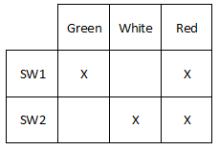coldplay2010
Member
Hello, I am a beginner with PLCs, so I am new to the ladder logic diagrams. I need help with the following:
1:When switch one (SW1) IS CLOSED, THE GREEN PILOT LIGHT TURNS ON
2:When switch two is closed, the white pilot light turns on.
3: When both switch one and switch two are closed, the Green and white pilot lights are off, and the red pilot light turns on.
I have completed simple ones, but this one confuses me. If you someone can show me the ladder logic diagram, it would greatly help me.
1:When switch one (SW1) IS CLOSED, THE GREEN PILOT LIGHT TURNS ON
2:When switch two is closed, the white pilot light turns on.
3: When both switch one and switch two are closed, the Green and white pilot lights are off, and the red pilot light turns on.
I have completed simple ones, but this one confuses me. If you someone can show me the ladder logic diagram, it would greatly help me.






